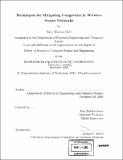Techniques for mitigating congestion in wireless sensor networks
Author(s)
Hull, Bret Warren, 1980-
DownloadFull printable version (9.890Mb)
Other Contributors
Massachusetts Institute of Technology. Dept. of Electrical Engineering and Computer Science.
Advisor
Hari Balakrishnan.
Terms of use
Metadata
Show full item recordAbstract
Network congestion occurs when offered traffic load exceeds available capacity at any point in a network. In wireless sensor networks, congestion causes overall channel quality to degrade and loss rates to rise, leads to buffer drops and increased delays (as in wired networks), and tends to be grossly unfair toward nodes whose data has to traverse a larger number of radio hops. Congestion control in wired networks is usually done using end-to-end and network-layer mechanisms acting in concert. However, this approach does not solve the problem in wireless networks because concurrent radio transmissions on different "links" interact with and affect each other, and because radio channel quality shows high variability over multiple time-scales. In this thesis, we examine three techniques that span different layers of the traditional protocol stack: hop-by-hop flow control, rate limiting source traffic when transit traffic is present, and a prioritized medium access control (MAC) protocol. We implement these techniques and present experimental results from a 55-node in-building wireless sensor network. We demonstrate that the combination of these techniques can improve network efficiency by a factor of three under realistic workloads.
Description
Thesis (S.M.)--Massachusetts Institute of Technology, Dept. of Electrical Engineering and Computer Science, February 2005. Includes bibliographical references (p. 99-105).
Date issued
2005Department
Massachusetts Institute of Technology. Department of Electrical Engineering and Computer SciencePublisher
Massachusetts Institute of Technology
Keywords
Electrical Engineering and Computer Science.